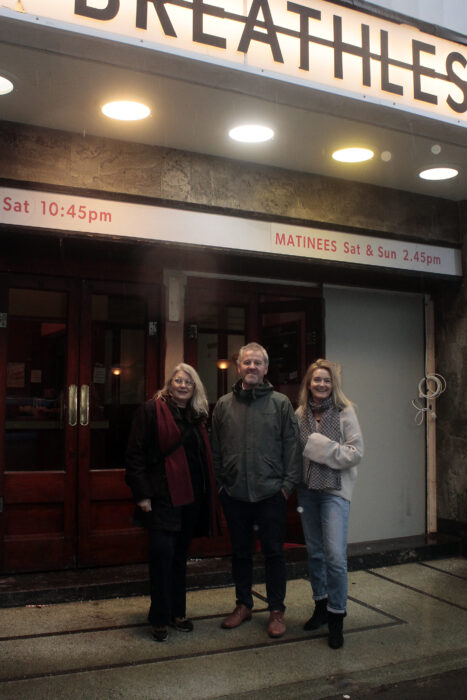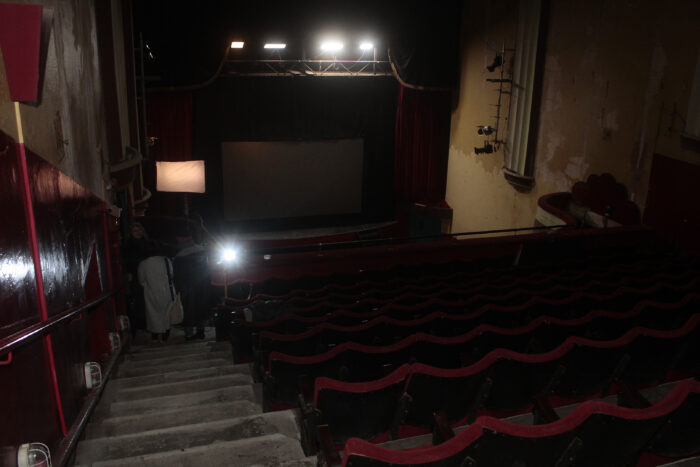
A FORMER Limerick cinema with a storied past that closed its doors to the public almost three decades ago has been given a new lease of life, and will soon be a star of the silver screen.
The former Royal Cinema on Cecil Street closed in the 1990s, but knew many guises since its original opening in the 1850s.
First opened as the Limerick Atheneum in 1852, the building only began showing movies in the early 1900s, before officially launching as the Royal Cinema in 1947.
The cinema had 600 seats and operated until 1985 when it closed down due to difficulties in the cinema trade, reopening again in 1989 as the Theatre Royal.
Following a fire in the early days, the venue reopened again in 1990, staging a number of concerts by well-known musicians during the 1990s.
The Cranberries, Mary Black, The Corrs, Boyzone, and The Prodigy all performed at the historic venue, while a number of episodes of the Chanel 4 sitcom Father Ted were also filmed at the Theatre Royal – most notably with the theatre providing a home to the Eurosong Contest where Ted and Doughal sang My Lovely Horse.
The Theatre Royal finally closed its doors for the last time in 1998 and has lain idle ever since.
That was until recently, when the former cinema and theatre was given a new lease of life as a set for Limerick director David Gleeson’s One Night Only.

The feature film stars Colin Morgan as a small town cinema manager who struggles to keep the peace on a busy Friday night at the movies.
The Limerick Post was given a tour of the former cinema by producers Nathalie Lichtenthaeler, Judy Tossell, and Film in Limerick regional film manager Paul C Ryan.
As part of the staging for the film, seats had be be re-installed in the main auditorium as the previous seating had been removed. The place was also given a fresh lick of paint to restore its movie magic look to glorious days gone by.
The Royal Cinema’s transformation has gotten the people of Limerick talking, Ms Tossell said, with many aiming to get a nostalgic glimpse into what remains of the once beloved cinema.
“The response from locals has been amazing, because so many people, either themselves or their parents, have stories, or their grandparents remember it. A lot of our extras are dying to get in because they want to see what it’s like now,” the film producer quipped.

Up in the balcony, the original theatre seats remain, now cleaned up for the production, while the ornate plasterwork on the ceilings also remains intact.
Other areas of the former cinema are in various states of repair, with significant water ingress and damp issues throughout the years the building was left idle and other bumps and bruises hinting at the life and activity that existed before.
Painting a vivid imagine, Ms Tossell said that “an extra was telling me they remember they used to throw bottles down in to the main auditorium and they just loved listening to them smash”.
Despite the building’s interior appearing to the untrained eye as a work in progress, Ms Lichtenthaeler said a hodgepodge of activity is a normal occurrence on film sets.
“It’s funny with film sets, they always look a little bit like a construction site. Then when you see the extra movie, you’re surprised how beautiful and calm and serene everything is,” she joked.
‘Limerick deserves a cinema in the city centre’
With the former cinema brought back to life for One Night Only, Paul C Ryan, the Film in Limerick regional manager, hopes that the building could be repurposed as a film hub for Limerick once the filming has wrapped up.
“Our hope at Film in Limerick is that the building would now be renovated fully as a cinema. Obviously that will cost a lot of money, and that will need to be raised, but it’s part of the Mayor’s plan to see a cinema in the city centre again,” he said.
“I think Limerick deserves a cinema in the city centre. Our vision for that is that we we have an independent cinema, a bit similar to The Stella in Rathmines, that type of model, a sort of place where it’s about big seats and comfort and showing independent and international and Irish movies.”

As well as that, in Film in Limerick’s dream vision, the cinema would also become a hub of education for the film industry in the Mid West, with training courses held there for aspiring filmmakers, producers, and directors.
“We also see it as a hub for all the film organisations and the film festivals. Everyone from Fresh Film Festival, the Richard Harris Film Festival, Emerging Limerick Filmmakers, Film in Limerick, and so on,” Mr Ryan explained.
Gesturing around the revamped theatre, the Film in Limerick boss said: “Look at what’s been done. It looks a million miles from what it was, and it’s very cosmetic for the camera, but what needs to happen now is that that we push on and continue the momentum to turn this back into a cinema for the people of Limerick.”










